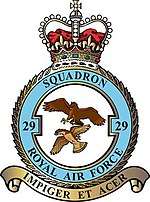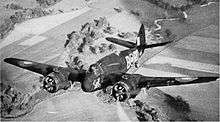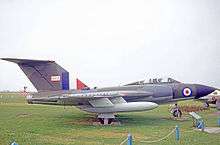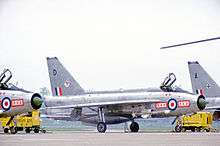No. 29 Squadron RAF
| No. 29 Squadron RAF | |
|---|---|
 | |
| Active |
|
| Country |
|
| Branch |
|
| Type | Operational Conversion Unit |
| Role | Typhoon training |
| Part of | No. 1 Group RAF |
| Home station | RAF Coningsby |
| Motto(s) |
Impiger et Acer (Latin for Energetic and keen)[1] |
| Aircraft | Eurofighter Typhoon FGR4 |
| Battle honours |
|
| Insignia | |
| Squadron tail badge |
 |
| Squadron badge heraldry | An eagle in flight, preying on a buzzard - representing air combat. |
| Squadron roundel |
|
| Squadron Codes |
YB (Dec 1938 – Sep 1939) RO (Sep 1939 – Apr 1951) BA–BZ (1987 – present) |
No. 29 Squadron of the Royal Air Force was first raised as a unit of the Royal Flying Corps in 1915, and is one of the world's oldest fighter squadrons. The second British squadron to receive the Eurofighter Typhoon, it is currently the Operational Conversion Unit (OCU) for the Typhoon.
History
Service in World War I
This unit was first raised as a reserve squadron, initially equipped with the Royal Aircraft Factory B.E.2c, in November 1915. In early 1916 however No. 29 became the fourth squadron to receive the Airco DH.2 "pusher" fighter, and arrived in France on 25 March 1916[2] – helping to end the Fokker Scourge and establish Allied air superiority in time for the Battle of the Somme.[3]
By late 1916 the DH.2 was outclassed by new German fighters, but No. 29 kept its pushers until March 1917, when it was re-equipped with Nieuport 17s. These were replaced with later Nieuport types, such as the Nieuport 24bis, as these became available. Due to a shortage of the Royal Aircraft Factory S.E.5a the squadron retained its Nieuports until April 1918, becoming possibly the last operational unit to operate "vee strut" Nieuport fighters. At this time the squadron finally received the S.E.5a, which it retained for the rest of the war.
The award of a Victoria Cross — the highest award for valour "in the face of the enemy" in the British Empire — to Captain James McCudden of 29 Sqn was gazetted on 2 April 1918, for McCudden's "conspicuous bravery, exceptional perseverance and a high devotion to duty", between August 1917 and March 1918. By the time of his death a few months later, McCudden had 57 official victories in air combat.
October 1918 was a bitter month for the squadron; four of its more notable members died within a fortnight. Claude Melnot Wilson was the first to fall, on 14 October.[4][5][6] Roderic MacLean collided with Lieutenant Henry Coyle Rath on the 26th, with MacLean dying that day and Rath lingering until the next.[7][7] Even as Rath was succumbing to his injuries, Guy Wareing was shot down on the 27th.[8]
After a short period with the army of occupation in Germany, the Squadron returned to the UK in August 1919 and was disbanded on 31 December 1919.
The squadron ended the war having claimed 385 victories. Apart from those already mentioned, the 26 aces who served with the squadron included:
- Edgar O. Amm
- Norman Brearley
- Sydney Brown
- Edgar G. Davies
- Francis James Davies
- Thomas Sinclair Harrison
- D'Arcy Fowlis Hilton
- Ernest Charles Hoy
- Arthur G. Jones-Williams
- Camille Lagesse
- William Molesworth
- James Dennis Payne
- Arthur Reed
- Charles G. Ross
- Reginald H. Rusby
- Alfred Shepherd
- Christoffel Venter
- Walter Bertram Wood
"Inter-war" years (1923–1939)

The squadron was reformed on 1 April 1923, initially equipped with Sopwith Snipes. These were replaced by Gloster Grebes in January 1925, In turn, these were replaced by the Armstrong Whitworth Siskin IIIA in March 1928 and Bristol Bulldogs in June 1932.
In March 1935, nearly twenty years after it was first raised as a single-seat fighter squadron, the squadron received two-seater Hawker Demons, which it operated until 1938. This included service in Egypt from October 1935 to 1936, during the Abyssinian crisis. The squadron also operated a few old Fairey Gordons for night patrols in Egypt.
As part of the Royal Air Force’s modernisation and expansion in the late 1930s, No. 29 received Bristol Blenheim IF heavy fighters in December 1938.
Second World War

No 29 began the Second World War with its Blenheims, which at the period operated as day fighters – especially on convoy protection patrols. From June 1940 it became a night fighter squadron, receiving some of the first Beaufighters in November, though it was February 1941 before the squadron was fully equipped with the new fighter. Various marks of the de Havilland Mosquito were flown by the squadron from May 1943 culminating in the Mosquito NF30. From the middle of 1944 most of the squadron’s missions took it over the continent.
1945 to 1998
During the immediate post-war years the squadron remained a night/all weather fighter unit. The Mosquitoes continued to serve until replaced by Gloster Meteor NF11s in August 1951. In November 1957 these were superseded by Gloster Javelins.



In January 1957 the squadron moved north, first to Northumberland and then in July 1958 to Scotland, conversion to Javelins taking having taken place in November 1957. In February 1963 No 29 moved to Cyprus and in December 1965 went to Zambia for nine months on detachment during the Rhodesian crisis.
From May 1967 the squadron operated the English Electric Lightning F.3 based at RAF Wattisham near Stowmarket in Suffolk until December 1974 when they re-equipped with the McDonnell F-4 Phantom and moved to RAF Coningsby in Lincolnshire. A detachment was stationed at Wideawake airstrip on Ascension Island during the Falklands War, moving on to provide defence of the Falklands in August 1982, following repairs to the airfield at Stanley.
In 1987, 29 Squadron was one of the first RAF units to receive the Tornado F3; deploying to Saudi Arabia after the Iraqi invasion of Kuwait in August 1990 and participating in Operation Desert Storm. No. 29 flew the Tornado until disbanding in 1998, as part of the Strategic Defence Review.
The current squadron
The squadron was reformed in 2003, this time as the Typhoon operational conversion unit (OCU). This is its current role.
Badge
The badge of the squadron shows an eagle in flight preying on a buzzard, symbolising air combat. The motto in Latin is Impiger et acer - 'Energetic and keen'.
Squadron markings and the "misspelled Roman numeral" tradition
Since the late 1920s, the squadron marking has been three (red) Xs (XXX). Since this closely resembles the Roman numeral for "29" (XXIX) there is a belief among current squadron personnel that this originated as a "misspelling" of the Roman numeral. Although various versions of the tradition are put forward, the most common explanation is that a mis-understood instruction to ground crew to paint "2 X's in front of the roundel and IX behind it" meaning "X,X,(roundel), and 'IX' or 'one-X'" resulted in "XX(roundel)'one times' X". In fact, the marking was always applied as "XXX(roundel)XXX" or as "XXX(roundel)" on smaller types, such as Siskins.
It seems probable that the original adoption of "XXX" for the 1930s squadron marking was nothing to do with Roman numerals, but was a reference to the brewers' mark for "extra strong", frequently applied to kegs of beer, and that it is only a coincidence that this resembles the numeral for "29" (XXIX).[9] It should be noted that the use of Roman numerals for numbering RAF units is a relatively modern development and it was certainly not the practice in the RAF in the 1920s. Nor, so far as it is known, has 29 squadron ever been officially referred to as "XXX squadron" – or as "XXIX squadron".
Summary of aircraft operated
- Royal Aircraft Factory B.E.2c 1915–1916
- Airco DH.2 1916–1917
- Nieuport 17/24bis 1917–1918
- Royal Aircraft Factory S.E.5a 1918–1919
- Sopwith Snipe 1923–1925
- Gloster Grebe 1925–1928
- Armstrong Whitworth Siskin III a 1928–1932
- Bristol Bulldog 1932–1935
- Hawker Demon 1935–1938
- Bristol Blenheim 1939–1940
- Bristol Beaufighter 1940–1943
- De Havilland Mosquito 1943–1951
- Gloster Meteor NF11 1951–1958
- Gloster Javelin 1957–1967
- English Electric Lightning F3 1967–1974
- McDonnell Douglas Phantom FGR2 1974–1987
- Panavia Tornado F3 1987–1998
- Eurofighter Typhoon F2 2003–present
List of Commanding Officers
| Rank | Name | Date Assumed Command | Notes |
|---|---|---|---|
| Major | Dawes, L | 7 Nov 1915 | |
| Major | Conran, E L | 25 May 1916 | MC |
| Major | Gratton-Bellew, W A | 5 Sep 1916 | MC |
| Major | Champion de Crespigny, H V | 22 Mar 1917 | MC |
| Major | Chapman, C M B | 21 Jul 1917 | MC |
| Major | Champion de Crespigny, H V | 4 Oct 1917 | MC |
| Major | Dixon, C H | 20 Nov 1917 | MC |
| Major | White, H G | 1 Apr 1923 | |
| Sqn Ldr | Twistleton-Wykeham-Fiennes, The Hon L J E[10] | 12 Aug 1923 | [11][12] |
| Sqn Ldr | Neville, R H G | 12 Aug 1924 | MC |
| Sqn Ldr | Taylor, M L | 10 Aug 1927 | AFC |
| Sqn Ldr | Scott P E | 6 Dec 1929 | |
| Sqn Ldr | Routh, E J D | 9 Jun 1930 | |
| Sqn Ldr | O'Neill, H D | 14 Apr 1931 | |
| Sqn Ldr | Butler, J H | 18 Aug 1933 | |
| Sqn Ldr | Chapman, C | 20 Aug 1934 | DSC |
| Sqn Ldr | Mackay, E P | 10 Dec 1935 | |
| Sqn Ldr | Fleming, D M | 14 Apr 1936 | |
| Sqn Ldr | Lynch, J B | 19 Aug 1937 | |
| Sqn Ldr | Jonas, R C | 17 Dec 1937 | |
| Sqn Ldr | Robinson, M W S | 2 Dec 1938 | |
| Sqn Ldr | Gomez, P S | 13 Feb 1939 | |
| Sqn Ldr | Bitmead, E R | 8 Jul 1940 | |
| Sqn Ldr | Widdows, S C | 16 Jul 1940 | DFC |
| Wg Cdr | Colbeck-Welch, E L | 13 Jun 1941 | DFC |
| Wg Cdr | Cleland, R | 10 Jul 1942 | |
| Wg Cdr | Wight-Boycott, C M | 10 Sep 1942 | DSO |
| Wg Cdr | Miller, C M | 20 Jan 1943 | |
| Wg Cdr | Mack, R E X | 12 Jun 1943 | DFC |
| Sqn Ldr | Arbon, P W | 23 Feb 1944 | |
| Wg Cdr | Powell-Shedden, G F | 29 Apr 1944 | DSO DFC |
| Wg Cdr | Allan, J W | 18 Dec 1944 | DSO DFC |
| Wg Cdr | Wood, T C | 31 Dec 1945 | DFC |
| Sqn Ldr | Hawkins, D | 1 Nov 1946 | DFC |
| Sqn Ldr | Young, M J B | 10 Mar 1949 | DFC |
| Sqn Ldr | Shaw, M | 7 Jul 1949 | DSO |
| Sqn Ldr | Bodien, H E | 15 Aug 1951 | DSO DFC |
| Sqn Ldr | Horsley, B P T | 30 Jun 1952 | AFC |
| Sqn Ldr | Sismore, E B | 11 May 1953 | DSO DFC |
| Wg Cdr | Aiken, J A C | 2 Jan 1956 | |
| Wg Cdr | Harbison, W | 2 Jan 1958 | AFC |
| Wg Cdr | Gordon-Cumming, A R | 15 Jul 1959 | |
| Wg Cdr | Gardiner, R E | 3 Jul 1961 | DFC |
| Wg Cdr | Jeffery, E G P | 18 Apr 1962 | |
| Wg Cdr | Burge, K | 1 Jan 1965 | |
| Wg Cdr | Neil, R | 23 Nov 1966 | |
| Sqn Ldr | Boyer, L A | 10 May 1967 | |
| Wg Cdr | Phipps, L W | 18 Sep 1967 | AFC |
| Wg Cdr | Carroll, B | 20 Jan 1969 | |
| Wg Cdr | Carter, P | 31 Jul 1971 | |
| Wg Cdr | Hawtin, J D C | 7 Jul 1973 | |
| Wg Cdr | Lavender, B W | 31 Dec 1974 | AFC |
| Wg Cdr | Oakden, D I | 4 Jul 1975 | |
| Wg Cdr | Elworthy, T C | 23 May 1977 | |
| Wg Cdr | Macfadyen, I D | 1 Feb 1980 | |
| Wg Cdr | Smith, G C | 17 Dec 1982 | AFC |
| Wg Cdr | Macfadyen, I D | 1 Jun 1983 | |
| Wg Cdr | Alcock, A J H | 2 Aug 1983 | MBE |
| Wg Cdr | Sudborough, N J | 13 Nov 1985 | |
| Wg Cdr | Doble, L A | 1 Apr 1987 | |
| Wg Cdr | Trotter, R W D | 10 Nov 1989 | |
| Wg Cdr | Hodgson, P | 24 Jul 1992 | |
| Wg Cdr | Routledge, M J | 20 Jan 1995 | |
| Wg Cdr | Randle, N | 18 Jul 1997| | |
| Wg Cdr | Hitchcock, J J | 1 Dec 2003 | |
| Sqn Ldr | Hargreaves, I J | 5 Nov 2004 | |
| Wg Cdr | Mackay, A J | 1 Apr 2005 | |
| Wg Cdr | Gregory, A J | 6 Jun 2007 | |
| Wg Cdr | Stringer, J J | 7 Sep 2007 | |
| Wg Cdr | Seymour, A J | Nov 2009 | |
| Wg Cdr | Pemberton, G A | Jan 2012 | |
| Wg Cdr | Heald, J DFC | Jan 2013 | |
| Wg Cdr | Bolton, J | Dec 2015 | |
| Wg Cdr | Chisholm A | Dec 2017 | |
See also
References
Notes
- ↑ Pine, L.G. (1983). A dictionary of mottoes (1 ed.). London: Routledge & Kegan Paul. p. 106. ISBN 0-7100-9339-X.
- ↑ Jones 1928, p. 147.
- ↑ Jones 1928, pp. 158–160.
- ↑ http://www.vac-acc.gc.ca/remembers/sub.cfm?source=collections/virtualmem/Detail&casualty=163472 Retrieved 23 February 2010.
- ↑ http://wwii.ca/memorial/world-war-i/104967/lieutenant-claude-melnot-wilson/ Retrieved 23 February 2010.
- ↑ http://www.theaerodrome.com/aces/canada/wilson2.php Retrieved 23 February 2010.
- 1 2 https://translate.google.com/translate?hl=en&sl=fr&u=http://medaillesdutournaisis.skynetblogs.be/post/5200349/ce-11-novembre-si-nous-passons-par-la-&ei=5ayES9yJH4PSsQOX1fGeDw&sa=X&oi=translate&ct=result&resnum=3&ved=0CAwQ7gEwAg&prev=/search%3Fq%3D%2522Guy%2BWilbraham%2BWareing%2522%26hl%3Den%26safe%3Doff%26client%3Dsafari%26rls%3Den Retrieved 23 February 2010.
- ↑ http://www.theaerodrome.com/aces/england/wareing.php Retrieved 23 February 2010.
- ↑ Robertson 1957, p. 68.
- ↑ Lawrence John Evelyn Twisleton-Wykeham-Fiennes
- ↑ http://www.theaerodrome.com/forum/1999/7469-maj-hon-l-j-e-twisleton-wykeham-fiennes.html
- ↑ http://thepeerage.com/p33655.htm#i336544
Bibliography
- Bowyer, Chaz; Franks, Norman (1971). "No. 29 Squadron RFC/RAF, 1915–1919". Cross & Cockade Great Britain Journal. 2: 93–121.
- Halley, James J. Famous Fighter Squadrons of the RAF: Volume 1. Windsor, Berkshire, UK: Hylton Lacey Publishers Ltd., 1971. ISBN 0-85064-100-4.
- Halley, James J. The Squadrons of the Royal Air Force & Commonwealth 1918–1988. Tonbridge, Kent, UK: Air Britain (Historians) Ltd., 1988. ISBN 0-85130-164-9.
- Jefford, C.G. RAF Squadrons, a Comprehensive record of the Movement and Equipment of all RAF Squadrons and their Antecedents since 1912. Shropshire, UK: Airlife Publishing, 1988 (second edition 2001). ISBN 1-85310-053-6.
- Jones, H. A. The War in the Air: Being the Story of the Part Played in the Great War by the Royal Air Force: Volume II. History of the Great War. Oxford: Clarendon Press, 1928.
- Rawlings, John. Fighter Squadrons of the RAF and their Aircraft. London: Macdonald and Jane's Publishers Ltd., 1969 (second edition 1976). ISBN 0-354-01028-X.
- Robertson, Bruce. Aircraft Camouflage and Markings, 1907–1954. Letchworth, Harleyford Publications, 1957.
External links
| Wikimedia Commons has media related to No. 29 Squadron RAF. |